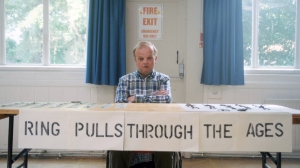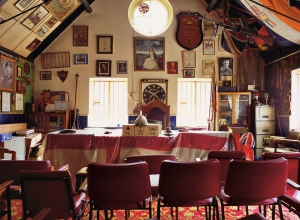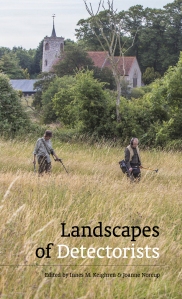Club Nights (or Watching the Detectorists)
by thenewenglishlandscape
Toby Jones in ‘Detectorists’
Just before Christmas, Historic England posted a blog, A Brief History of Community Centres in England, illustrated by contemporary colour photographs showing modest and occasionally eccentric buildings scattered across the country. While of minor interest to some architectural historians, attention is now being paid to buildings that have nevertheless played a social role out of all proportion to the modesty of their design and function. From Quaker meeting houses, parish halls and charity settlements, to Labour Clubs, British Legion Halls and Women’s Institutes, the variety is fascinating. Equally numerous are village halls commemorating the First World War or the 1953 Coronation, along with a lively mix of independent religious and ethnic minority community centres.
Many years ago, I spent a fortnight cycling from John O’Groats to Land’s End on a charity bike ride. What I remember most from that journey was the endless succession of First World War Memorial Halls we passed, as we pedalled from one village to the next. A number played host to us, acting as pit stops, providing tea, sandwiches and cakes. Some were little more than breeze block halls with a cloakroom, toilets, kitchen and a serving hatch; a couple no more than corrugated tin sheds. Others, though, had full blown raised stages, proscenium arches, pianos, along with fully stocked licensed bars, mirror balls, and PA systems. Yet none would have cost more to build than a suburban family house, though their social role was invaluable.
Just before Christmas I gave a talk in one such hall, two hundred yards from where I first went to school at Davis Lane Primary, just off Leytonstone High Street. The plain brick church hall attached to St John’s Church has been home to a series of monthly Saturday evening talks for nearly 25 years, under the rubric of ‘News from Nowhere’: a regular and popular gathering for the discussion of radical ideas about how we live and how we might live (to cite the words of the forum’s guiding spirit, and local hero, William Morris). The setting reminded me of an aphorism coined by the contrarian, Stuart ‘Whole Earth Catalogue’ Brand, in his polemical architectural treatise, How Buildings Learn, where he asserted that new ideas only come from old buildings, suggesting that new buildings wipe historical memory clean. The atmosphere was suitably low-key and modest, yet wonderfully convivial, with tea and cakes served from behind a traditional serving hatch.
General Browning Moth Club © Bridget Smith
Such buildings, while basic in construction and fitting out, are frequently rich in interior decoration and memorabilia. Nowhere has this been better documented than in artist Bridget Smith’s collection of photographs of London club interiors in her book, ‘Society’, published some years ago by General Public Agency. In his appreciative Afterword, cultural critic Sukhdev Sandhu writes of the ‘pocked notice-boards, national flags, shimmer curtains and mirror balls that evoke stage sets for future debates, but also a provisional and tentative unity underpinning seemingly unconnected organisations.’ He goes on to cite the motto of the Women’s Institute, to ‘make a difference – to the life you lead, to the community you are a part of and to the world you live in.’
Smith’s succession of forty-six colourful club tableaux evinces a profound range of attachments, to identity, shared aspirations, and belonging. These are the clubs of the ‘small platoons’ of society, to cite Edmund Burke’s words – as Sandhu himself does. In her introduction to ‘Society’, Bridget Smith describes the wish to commemorate and celebrate ‘where I live my life, the people and places I encounter and the worlds they create for themselves’, employing the phrase: ‘Dig deep where you are’. This was once a watchword in the community arts movement, and originated as the title of Swedish book by Sven Lindqvist first published in 1978, Gräv där du star, literally ‘Dig where you stand’. By happy coincidence this pioneering work of ‘history from below’ is finally to be published in an English translation in March 2023 by Repeater Books.
Digging deep is taken literally in the BBC television series, Detectorists – for some time a cult programme for landscape enthusiasts. Three series since 2014, and a Christmas Special just broadcast, follow the trials and tribulations of two enthusiastic members of the fictional Danebury Metal Detecting Club (DMDC) and their fellow detectorists, whose weekly meetings are held in the local Scout Hall. While a number of conventional tropes of situation comedy are lovingly employed, underlying each episode is a haunting awareness of the fragile bonds of friendship and community, in a moving excursion of bitter-sweet, open-air theatre.
An absorbing collection of essays about the making of Landscapes of Detectorists, has now been published by Uniformbooks, one of the most original and elegant small presses currently at work in the UK. It is a must-read for those interested in how landscape aesthetics can be explored in popular form while remaining true to the ideas and traditions of human topography. As producer Adam Tandy mischievously writes in his Afterword, ‘BBC Four was basically invented to allow comedies to reference the Venerable Bede.’
Until reading this book I hadn’t realised that writer and actor Mackenzie Crook was inspired to write Detectorists after playing a leading part in Jez Butterworth’s impassioned 2009 play on contemporary rural life and mythology, Jerusalem. Cook’s original vision of the series was, he recalls, initially a much darker vision, more bleak-midwinter (when most metal detecting goes on) than a summer idyll: and more a story of mistrust and in-fighting than friendship. But as the storyline developed, and the characters began to take life, something deeper was brought to the surface: one of amiable ‘citizen-scientists’ taking history back from the professionals, and in doing so weaving a study of modern-day rural life, its social upheavals as well as its pastoral compensations. I loved the series and I loved this book – a real Christmas treat. Happy New Year.
KW
Very pleased that No Matter How Many Skies Have Fallen: back to the land in wartime Britain, has already been reprinted. More details: https://www.littletoller.co.uk/shop/books/little-toller/no-matter-how-many-skies-have-fallen-by-ken-worpole/
I’ll be giving a talk about the book at the Essex Record Office in Chelmsford, on Tuesday, 7 February 2023. For more details and booking: https://www.eventbrite.co.uk/e/ero-presents-no-matter-how-many-skies-have-fallen-tickets-459925608877


